The Factions of Eo
The Realm
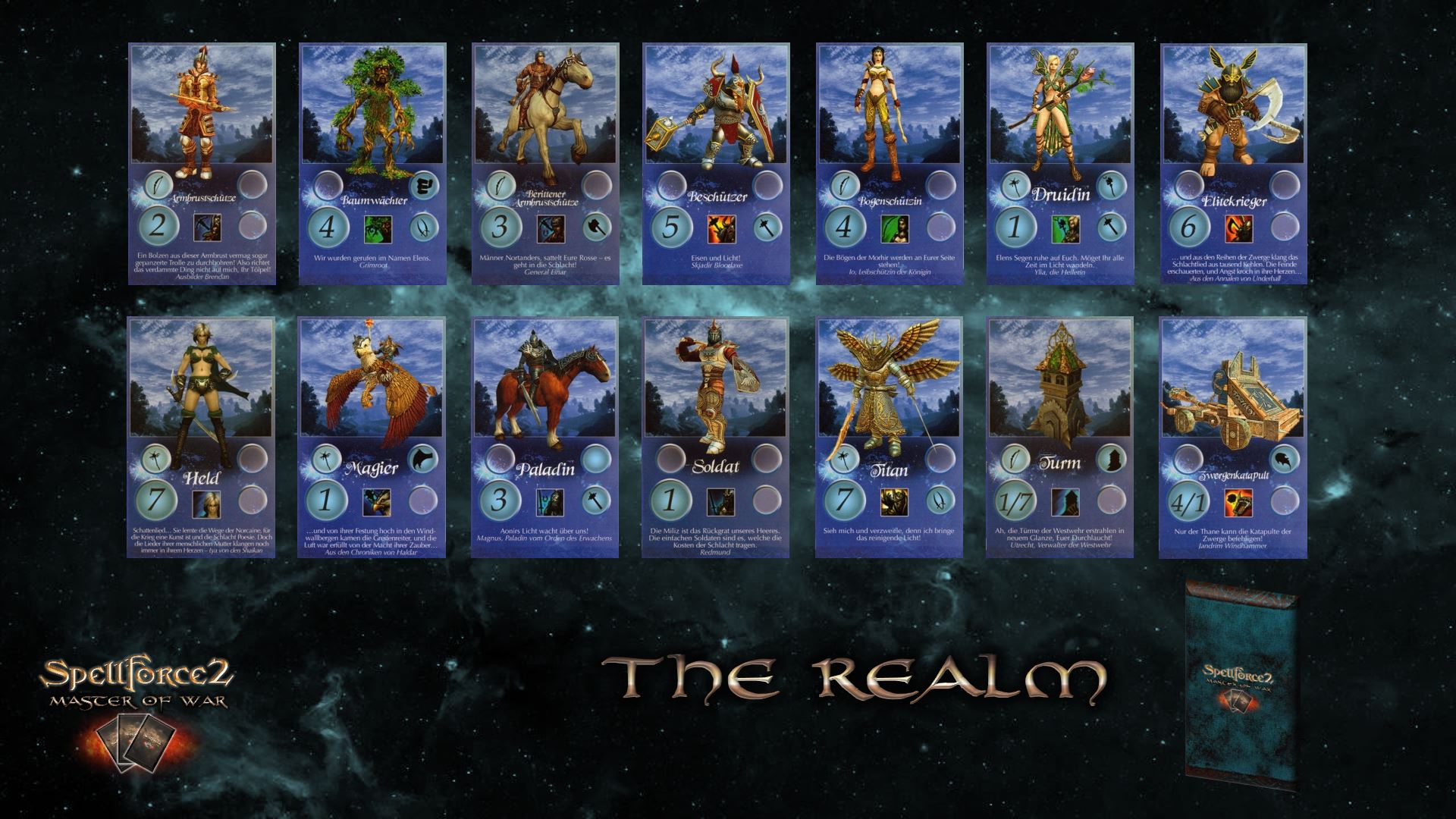
There may well have never been a human empire, nor the legends of the Dragon Slayers, if many millennia ago, a few dwarves had not set out from their home in Grimwarg to seek adventure in the distant peaks of the Windwall mountains. They had hoped to find good stone, valuable metals and a new home, but found only barren rock and a few tribes of wild barbarians living in inhospitable caves in the frozen heights. And though these creatures appeared to the dwarves as weak and primitive – their lifespan was barely longer than that of most animals – they immediately recognised the willpower and lifeforce that had been instilled in these creatures. Impressed by the barbarians, the dwarves stayed and began to teach them of the world, the Gods and the art of forging.
Never would those dwarves have thought that their actions might change the world forever. Greedily, the humans devoured their knowledge, learning each move and all the wisdom of their teachers, and this wisdom spread like wild fire. Soon, the first smith’s hammers began to ring in the Windwalls and formed the first of the great swords that were to become the human’s trademark. With these weapons, they descended from the mountains and took control of the plains, their numbers ever increasing. The Age of Swords had begun.
Although the mighty dragons were the indisputed rulers of the land of Fiara, even their formidable might could not stop the humans’ advance. With lances and swords, they confronted the ancient lizards and accomplished the impossible, a feat that neither dwarf nor elf had managed: They drove back the dragons. With courage and creativity, they defeated one mighty dragon after another and filled the once empty plains with villages and cities.
With their victory over the ancient rulers of Fiara began the rise of the humans, a race that was both good and bad, courageous and cowardly, strong and yet weak, the strangest and most varied of all races of this world. And with their rise came cities, trade, money and war.
The elves, the oldest and noblest of all races, come from the forests of southern Fiara. The magnificent trees of the Finon Mir provided protection against the powerful dragons, allowing these children of nature to prosper and live in relative peace under the roof of leaves. Elves grow tall, yet are of delicate stature, and their lifespan is much longer than that of other races. What they may lack in physical strength is more than compensated by their bravery and wisdom.
For as long as they can remember, the elves lives peacefully in their forests, but with the demise of the dragons came humans, and with them trade and war. In the end, the elves were forced to either fight or perish – and fight they did, earning themselves a reputation as feared warriors, better as friends than as foes. Today, the elves have allied with humans and dwarves in order to face the menace of the dark races. None can match their prowess with the longbow, and they have learned to use the magic of nature and ice. The mages of the Circle knew of the elvish talent for magic and their use in battle, and created many runes to make use of their skills.
Since the wars against the dark races and the time of the Circle, the elves have been living in clans strewn all across Fiara. Few survived the Convocation, however, so it is rare to meet one of these noble creatures in the northern lands.
The best weapons and armour in Fiara come from the dark slopes of the Grimwarg Peaks and the snow-covered summits of the Windwall Mountains, items that are highly valued and traded among the races of the light. These amazing wares are forged by the smiths of the dwarves, a race small in height, but of amazing strength and unshakeable courage. Like the elves, the dwarves are an ancient race that survived the reign of the dragons hidden deep in the labyrinth of caverns under the Windwall Mountains. While the giant lizards ruled the air, the dwarves drove the mines and shafts of their stony home deeper and deeper in the rock. There, they found discovered their destiny to work with rock and ore, bonding with the spirits of the earth and the god whose realm is the rock foundation of the world. They became the servants of Bjarne, the Soulsmith and Warrior God, who deep under the surface forges the souls of all living creatures until they become strong and solid. And so it came that the dwarves also became a strong race, a race of builders and blacksmiths, but also of warriors and heroes.
Courage and strength are the pillars of their life, and despite being known for a certain greed for gold and other jewelry, they are the only values they truly recognize. And though they may often seem reserved and condescending, they are always ready to help a true friend in need of their aide. Today the dwarves not only live in the dark shafts under the peaks of Grimwarg, but have created imposing cities of stone where they trade with the other races of the light. These are Fastholme, which stands under the old mines at the foot of the Grimwarg Mountains, and Windholme, which is an imposing sight in front of the snow-covered peaks of the Windwall, where it provides cover from the southern storms. There, the hammers of the master smiths ring constantly and merchants loaded with the most valuable of steel and silver travel to all regions of Fiara. And when it comes to war, the closed ranks of dwarf warriors will march from there with their indestructible armour and feared axes, always ready to support their brothers of the light.
The Clan
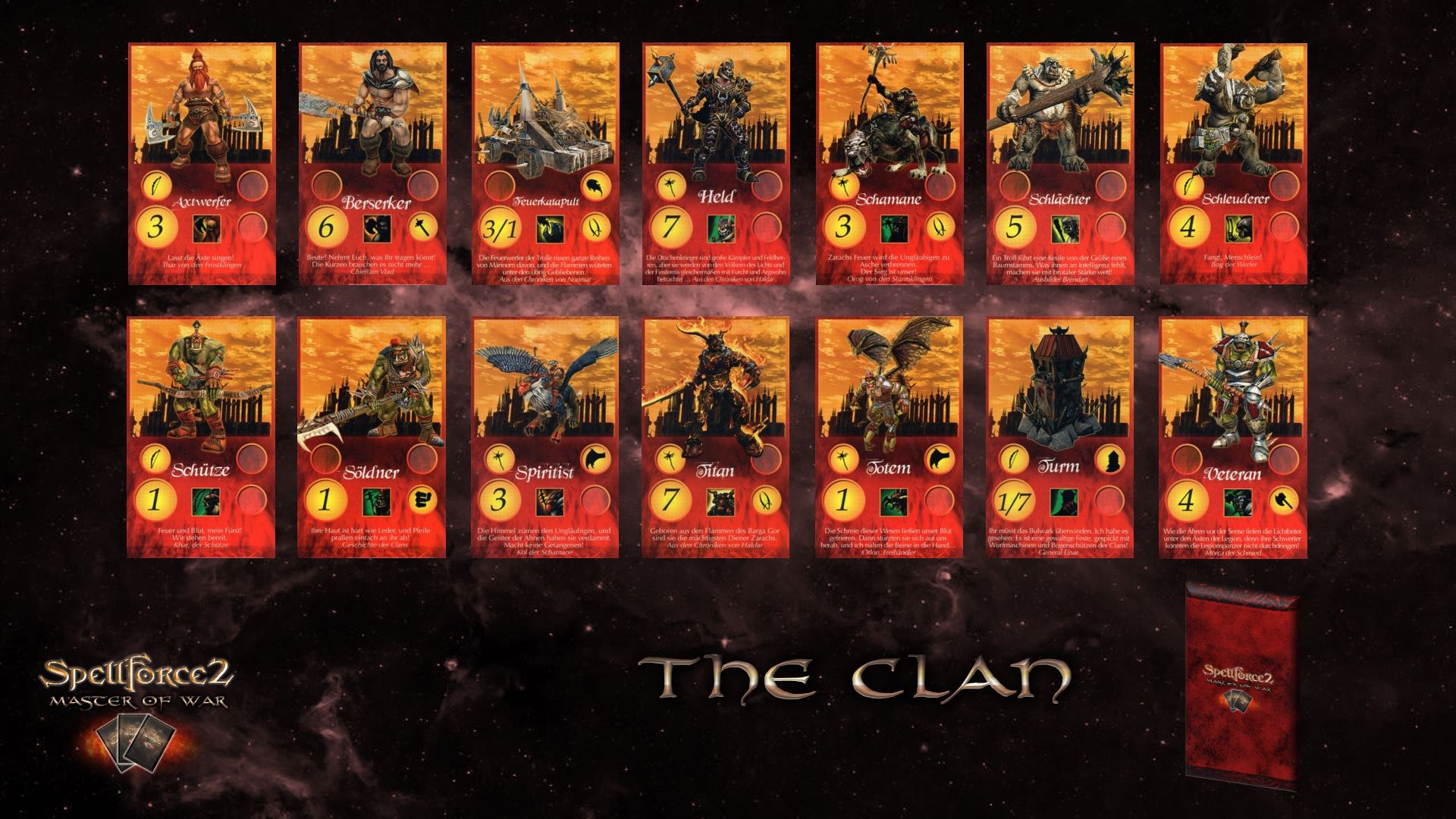
When Ulm the Caretaker broke the rules of his father Aonir and became Zarach the Bloodthirsty, his first goal was to create his own race, a people who would follow him blindly and worship him only. Driven by this desire, he began to shape new forms of life, moulding them with his will, and produced all manner of heinous creatures. Incomplete and deformed were these beings, horribly disfigured and unfit to survive for long, let alone breed.
Enraged by many years of fruitless labor, he descended to the earth and stole the children of the noble races, races that had been created by the natural order of his father. Abusing the perfection they had received through Aonir’s power, he infected them with his evil and formed them to his liking. Thus he was able to create his own race, strong and enduring creatures in which he instilled a bloodthirst and longing for battle. He named his creation “orc”, which in the dark tongue means “conqueror”.
They were chosen to be the bearers of his will, to be dogs of war, existing only to mercilessly conquer all other races and taint Aonir’s world with the sign of the Blood God. In dark temples in the middle of the steaming jungles of Xu he gave them life and from there, he drove them out into the plains, where the orcs’ existance began. It was a brutal and sparse life that the first tribes led, but with their bestial instincts and their seemingly endless endurance, they not only survived, but increased their numbers rapidly. Great hordes soon began to scour the lands, looking for prey, and in their settlements the sound of blacksmith’s hammers was always to be heard, forging iron into make weapons. Their instincts often drove them to imprudent behaviour, yet a part of the old races’ wisdom survived within these beasts. An orc may be greedy and combative, but he is not stupid.
Zarach’s nefarious plan to conquer the old races might even have succeeded, had his orcs not been so eager to do battle, even against each other. Time and time again, bloody wars erupted between the tribes, and only few leaders were ever able to unite the tribes – and then only for a short while. If ever a tribe leader were strong enough to assemble the armies of all tribes for an extended amount of time, the other races would hardly stand a chance. Even now, most tremble in fear at the sound of orcs crying for blood.
After having created the wild orcs, Zarach was dissatisfied with his creation and angered by his failure. He had hoped to create kings of the battlefield, but had only succeeded in fabricating simple warriors. And so he began anew, distorting the bodies of captured creatures to monstrous size and burning out any part of them that was not useful for battle and killing.
And thus he created the trolls. He made them stronger than any other race, more enduring and almost immune to pain, but in his eagerness to create a race of ultimate warriors, he took too much of their spirit, rendering them simpleminded and emotionless.
While the trolls are the undisputed rulers on the battlefield, they live as paupers in simple housings of stone and wood. Their limited skills and intellect only allow them to roughly trim rock and fashion simple clubs from treetrunks. They are as poor in mind as they are art, without legends, songs, living only for the now, for food and to kill.
This is the price they pay for the incomparable strength and wildness that makes them raging beasts on the battlefield, whom neither spears nor arrows can stop. They know neither pain nor fatigue, and their insatiable lust for blood drives them like a storm through the ranks of their enemies, their tree-like clubs killing and maiming wherever they land. What trolls lack in dexterity and cunning, they compensate with strength and power of resistance, and their ability to fight even after having sustained mortal wounds. Pain does not weaken them, it only makes them angry. And despite their primitive weapons and armour, and their lack of tactical thinking, an army of trolls is like a wave of destruction that can, with the right guidance, win battles by brute force alone.
The Pact
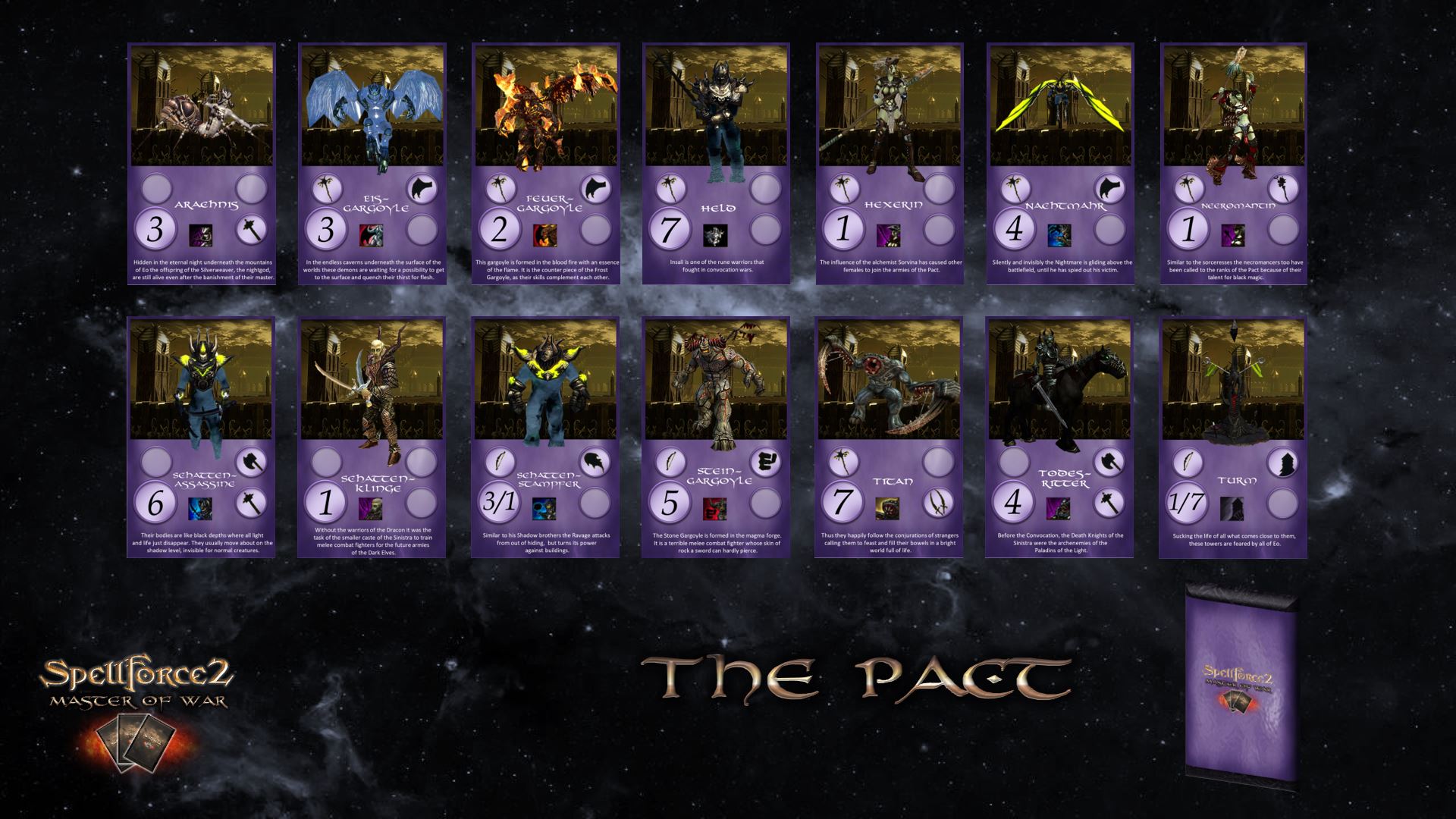
Nor, the Silverweaver, god of night and lord of the silver disc of the moon, was the first guardian to descend to the earth and tell the races of the guardian gods and their duties. But with time, the races forgot his teachings and turned away from the cool master of darkness, seeking instead solitude with the gods of light and the sun. Disappointed and spurned, Nor was quick to side with the renegade Zarach when the gods began to disunite. As a token of gratitude, Zarach created a race for his dark brother, a race that for all times would be devoted to Nor, master of the night. From the pure essence of the elves he formed the most beautiful, perfect and deadly of the dark races, the Norcaine – also known as Dark Elves.
Their spirit is sharp and cold as the light of the full moon, and they are as quick and merciless as the icy nightwind. War is their art, battle their poetry. They live to sow destruction and neither hope nor joy is necessary to give them courage. Perfect tools of death, they show no weakness, despair or fatigue. Their entire days and nights are spent worshipping and praying to Nor, their master, and destroying the light-seeking worms whose gods forced him into exile.
It is their sharp intellect and discipline that makes the Dark Elves so dangerous and that almost decided the War of Six Races for the dark ones. From Urgath they came to Fiara with their brothers in arms, the orcs and trolls. Once the war was over, they stayed and founded the realm of Lar on the nebulous east coast. There, they raised towers of obsidian and forged heavy armor and moonblades, which they would use in uncounted cruel battles against the races of the light.
The heart of the Pact consists of the Dark Elves, the people of the nightgod Nor, known as the Norcaine. The culture of the Norcaine has always been shaped by the fight between the two largest castes, the warriors of the Dracon and the sorcerers of the Archons. While the warriors are striving for an honourable life in the fight against the Light, the Archons are recklessly striving for power.
This striving made the current High Archon Toth Lar forge the bond with the Shadows with the help of his mother Sorvina. He gave a part of the power of life of his people to the Shadows and in return got the invisible Assassins who slaughtered his antagonists in the caste of the warriors within just a very short time. The honour of the Norcaine died along with these warriors.
But the Dark Elves have been dragged out of their paralysis that was caused by this inner conflict and now they are ready for new campaigns.
The new allies of the Norcaine, the Shadows, are invisible in their normal form and only become visible when they want to or when their lethal blow hits its target. It is known that they came to Eo from another world, but nobody really knows their goals and plans.
The gargoyles are no real members of the Pact. They are bloodthirsty demons from the inner centre of the world that have been given a form by magic. Grateful for their new bodies and happy to quench their blood thirst at last they throw themselves into battles for their masters. Sorvina’s knowledge as an alchemist of the Silver Hand enabled her to join these creatures into the army of the Pact.
The Shaikan
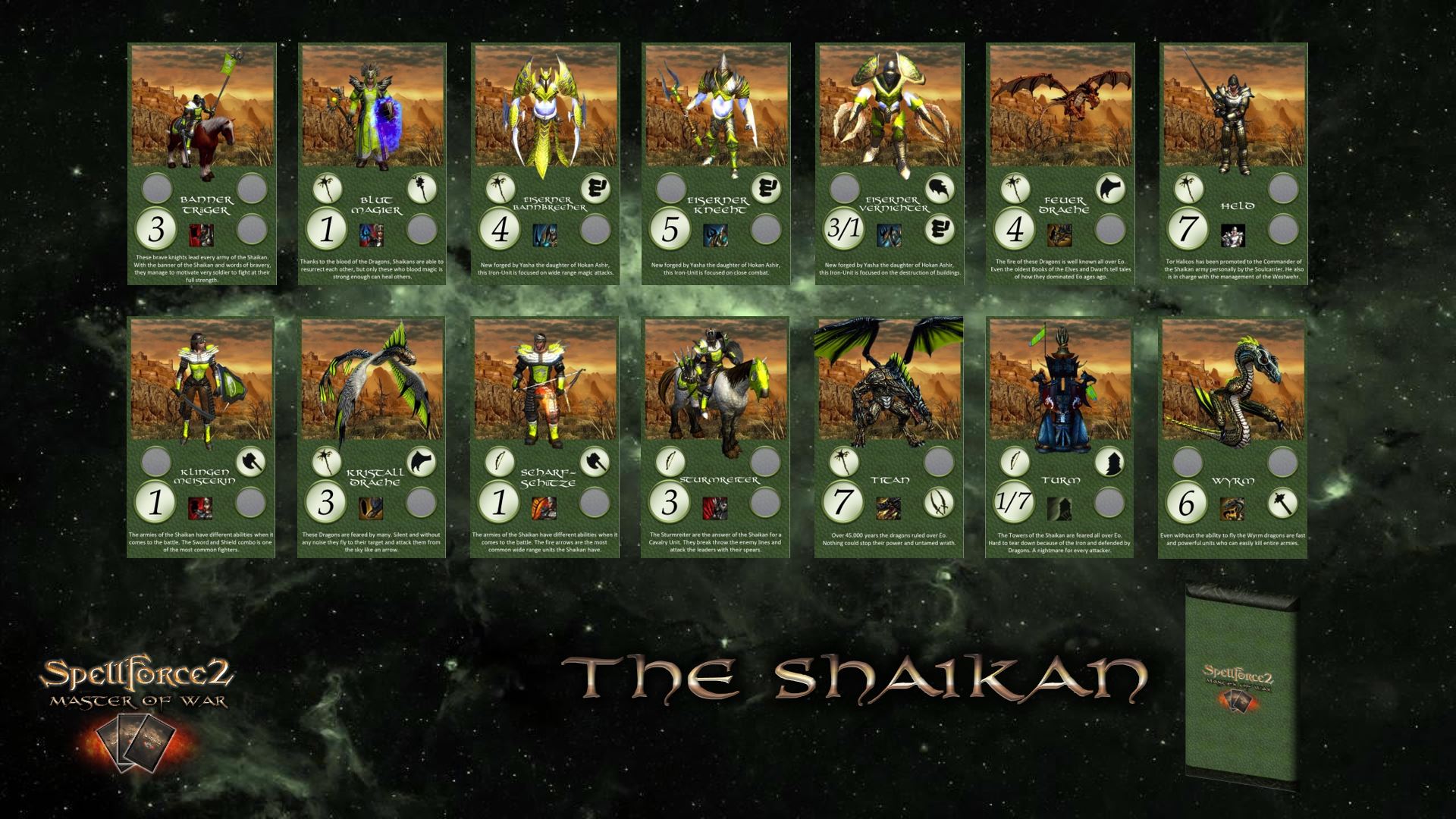
...began a thousand years in the past with Janus Malacay, the highest alchemist at the court of the first emperor of the Northern People. On the search for the power of the Materia Prima, that germ of life that can still be found in the blood of the first creatures of the world, back then Malacay joined his blood with the blood of the captured dragon named Ur. Thus he created a bloodline in whose veins the blood of the dragons was mixed with the traces of the humans' ancestors and which created a substance full of vital forces. In it the original spark of life, the germ of creation, came back into being. This blood not only made Malacay’s children stronger, faster and more robust than common people, the vital forces of the dragon blood sometimes even bestowed them with the ability to resurrect others by donating some of their blood.
They are the descendants of the alchemist Malacay, who once saved the life of the dragon Ur, receiving its eternal subservience in return.
In order to seal this pact, the dragon agreed to enter into a blood pact with a person – something that had never happened before. This was nevertheless the only good deed that Malacay ever did. He became increasingly insane and met a dreadful end.
His descendants have nevertheless preserved the tradition and continue to live under the protection of the ancient dragon. Each of them enters into a blood pact with him. These dragon warriors are great fighters and commanders. Their ancestry means that they are revered by both the Light People and the Dark with an equal degree of fear and distrust. They therefore live between the fronts, belonging neither to the light nor the darkness.
The Dark Elves call them “Shaikan”, which means both “godless” and “free”. This dichotomy captures and describes the life of these dragon warriors so accurately that they adopted this description as their own name over time.
The Undead
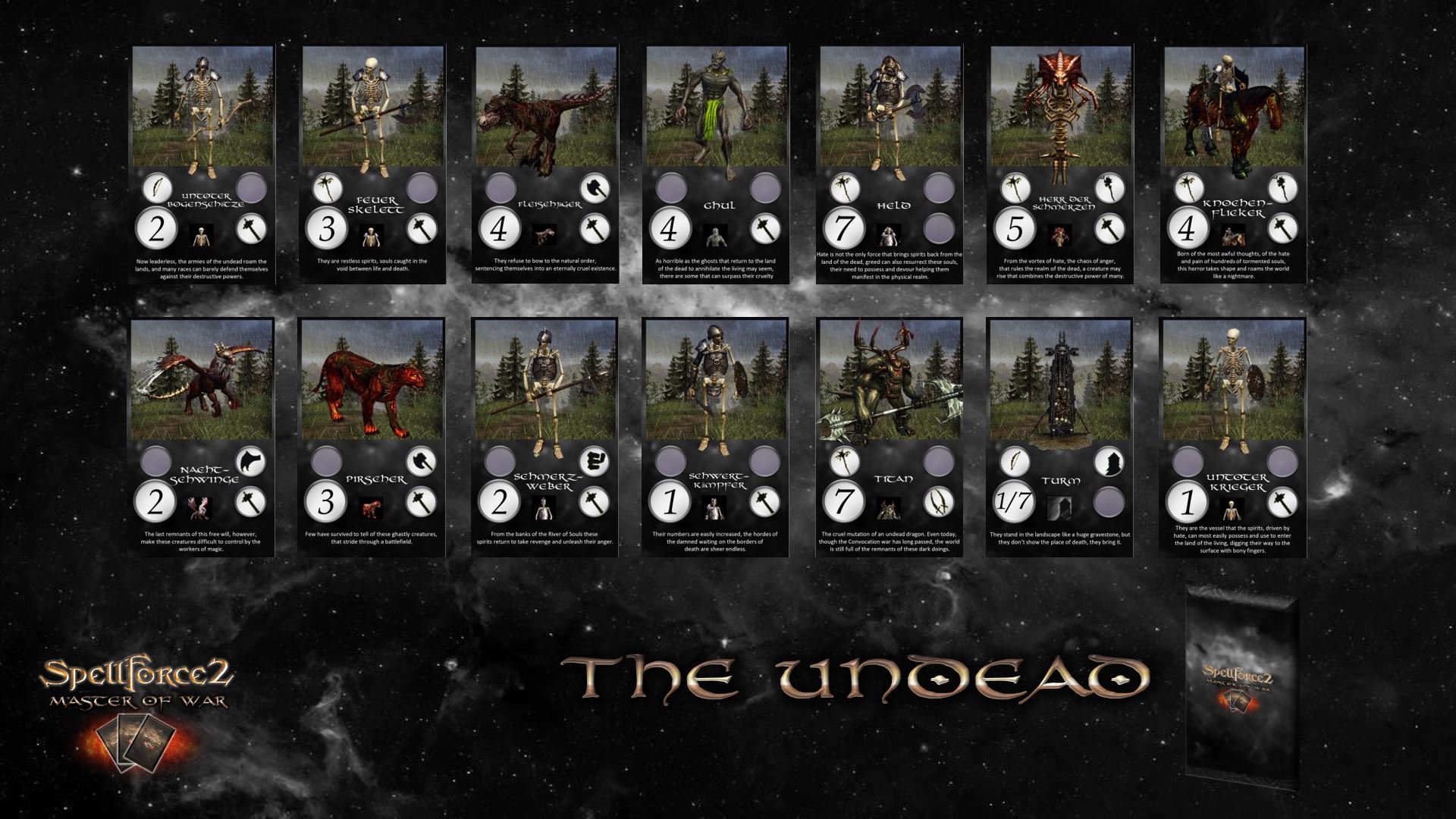
Life and death – the eternal circle of life. The natural order of the world. The way it has been, and the way it always will be. Or at least the way it should be, for magic, combined with the malice and thirst for power of certain races, has created abominations of nature, creatures of horrible appearance, and the most unnatural of these are those that go by the name of the Undead.
They are restless spirits, souls caught in the void between life and death. From beyond the threshold to the realm of the dead they look back on the world of the living, full of jealousy and loathing for the world they once inhabited. They refuse to bow to the natural order, sentencing themselves into an eternally cruel existence. A few of them manage to infiltrate the land of the living and manifest there by desecrating the bodies of the freshly dead or possessing the remains of those that died long ago. These revenants are the undead, and no living creature is spared from their wrath, so driven by hate are these unnatural beings.
Their senseless appetite for destruction makes them ideal for the battlefield, and over the years, many mages have tried to harness the power of these creatures for their own purposes. These mages are know as Necromancers, and can control the hordes of the undead, summoning them at will.
Even today, though the Convocation war has long passed, the world is still full of the remnants of these dark doings. Now leaderless, the armies of the undead roam the lands, and many races can barely defend themselves against their destructive powers.
The Beasts
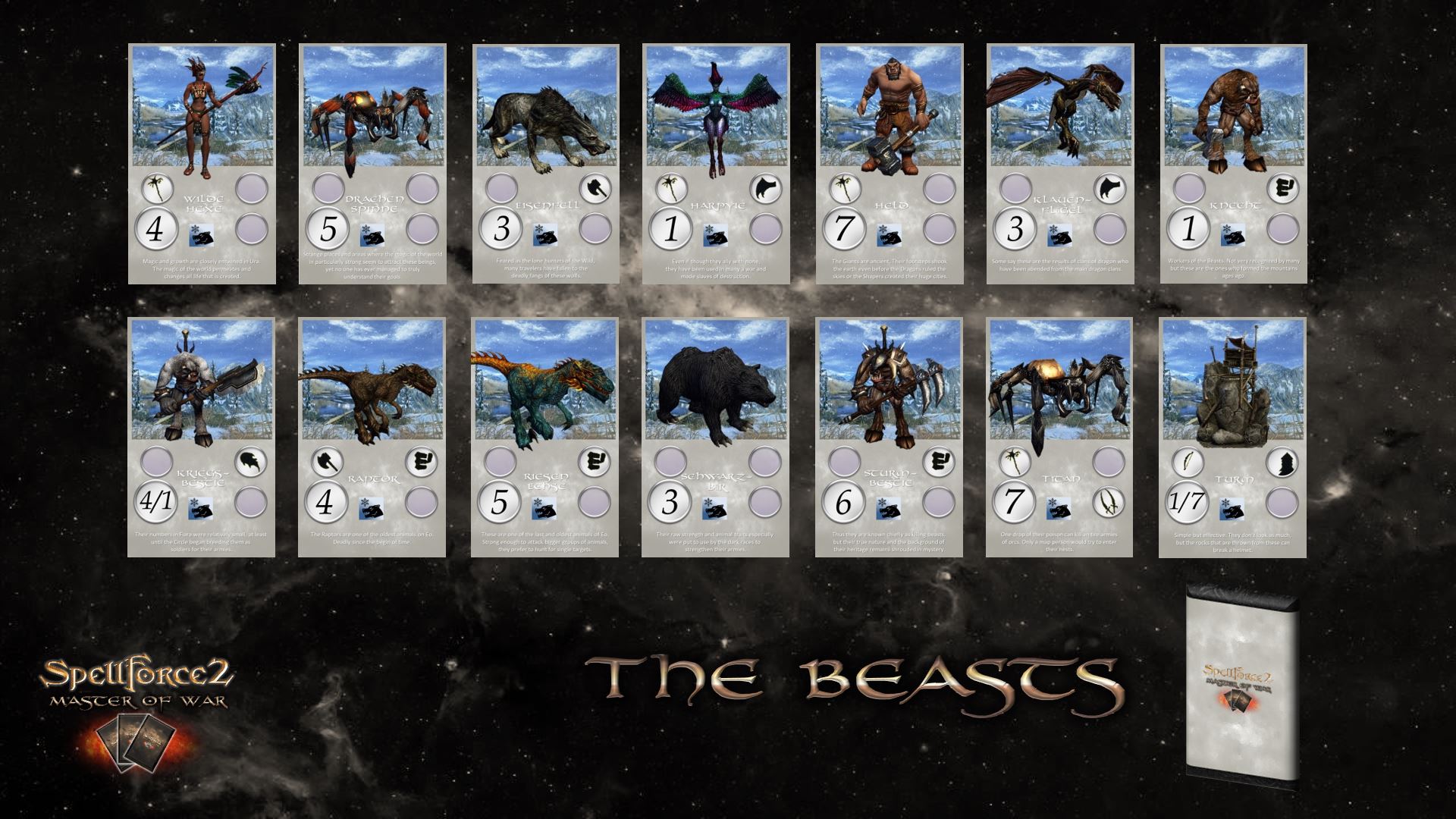
Magic and growth are closely entwined in Ura. The magic of the world permeates and changes all life that is created. Throughout their evolution, all living beings have undergone many changes, but from times before the higher races first saw the light of day, some creatures have survived almost unchanged - creatures as wondrous as they are dangerous. Some of these creatures even resemble the human form, a fact that has puzzled writers and scholars for generations.
Strange places and areas where the magic of the world in particularly strong seem to attract these beings, yet no one has ever managed to truly understand their goals. What is known, however, is that they are as merciless and cruel as the elements they have withstood for centuries. And even if though they ally with none, they have been used in many a war and made slaves of destruction. Their raw strength and animal traits especially were put to use by the dark races to strengthen their armies.
Thus they are known chiefly as killing beasts, but their true nature and the background of their heritage remains shrouded in mystery.
The Demons
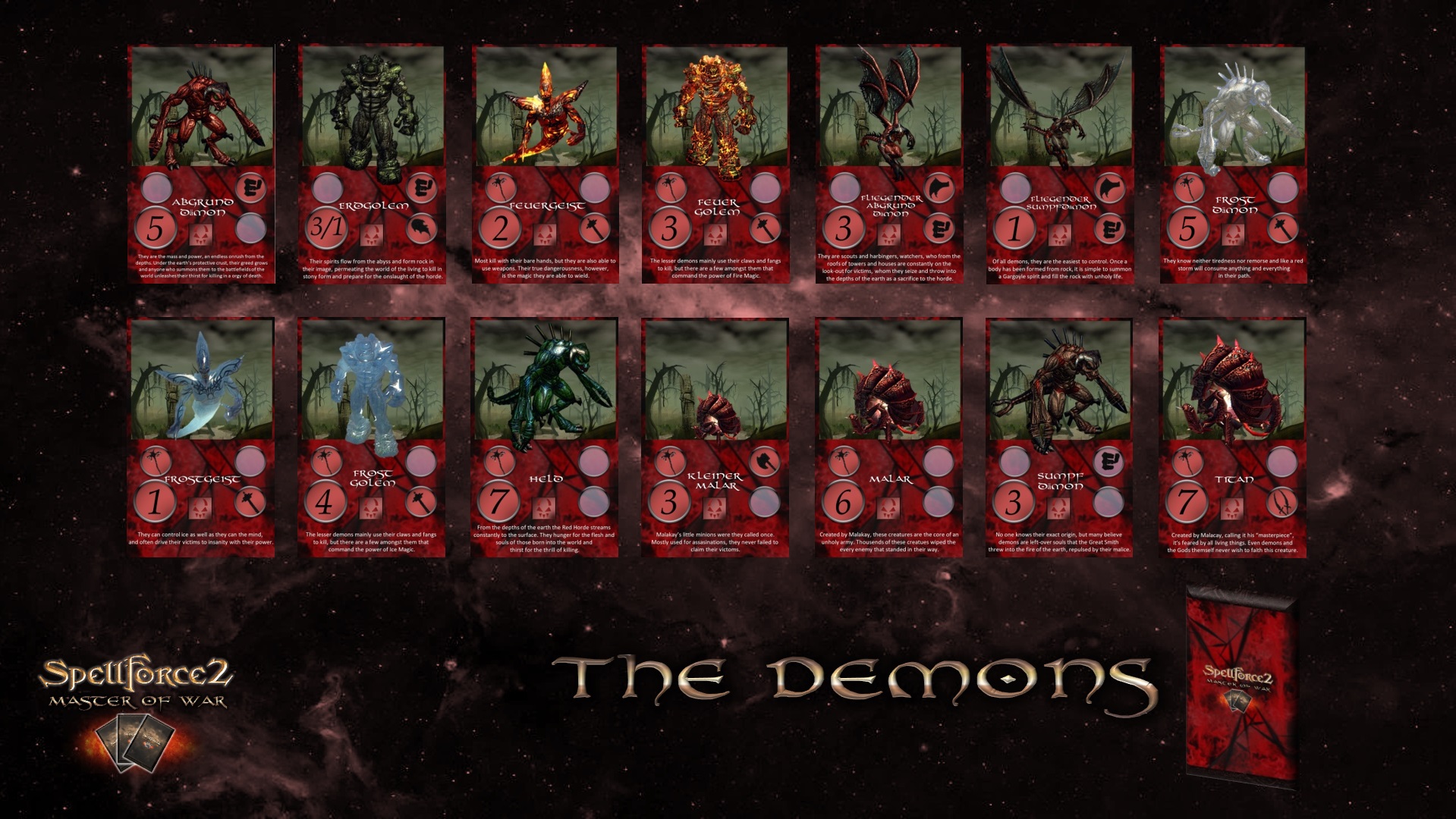
From the depths of the earth the Red Horde streams constantly to the surface. They hunger for the flesh and souls of those born into the world and thirst for the thrill of killing. Long ago, they came from the burning gorges of the Barga Gor and their number was legion. The armies of the world fought valiantly to drive back these creatures, but in the end, the power of the Gods was necessary to collapse the Barga Gor and banish the demons into the caverns below the surface. Yet still, they strive to come ever closer to the light, and will readily appear for those who would summon them from the depths. They fight with passion, and only one powerful in the arts of magic can hope to control their bloodrage.
No one knows their exact origin, but many believe demons are left-over souls that the Great Smith threw into the fire of the earth, repulsed by their malice. For whenever Bjarne, the Soulsmith, takes a new soul from the River of Souls to form it for a new life, he checks his work carefully. Many souls are filled with such viciousness or guilt that he throws them back into the blaze, for never would he be able to form good from them. And so they burn, unable to return to the River of Souls, until their evilness forms its own shape. Deformed figures they are, ugly and grotesque, yet malice and greed give them power that those born on the surface learn to fear even in their dreams. Even though they lurk many miles below the earth, their power reaches far and their faces live in the twitching shadows, the dark corners and nightmares of the world as a sempiternal memorial of danger.
And as the world becomes more and more evil and cruel, the more these creatures ache to reach the surface, where they would celebrate the victory of their unnatural existance in their thirst for war.
Do you have what it needs to become the Master of War?
Take the challenge and fight the world!
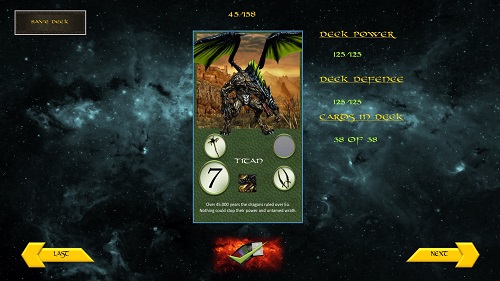
Defend your Side or you will be killed.
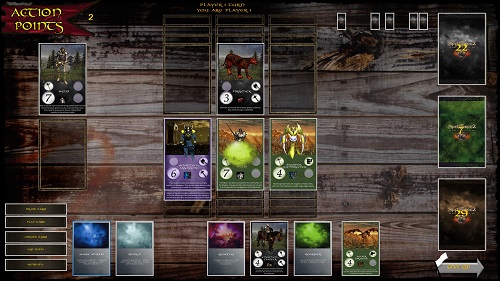
Setup your army and order your front lines.
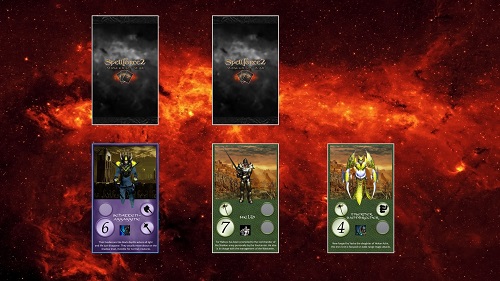
Use powerful spell to power your army up.
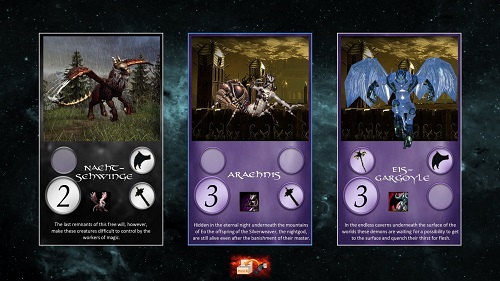
Send your troops into the battle and fight your enemy.
Rank & RPG System
In Spellforce 2 - Master of War you can level up by defeating your enemy’s on the battlefield. You can earn Medals from Rank 1 (beginner) up to the most awesome rank of all, Master of War (30)! Earn over 30 medals in Multiplayer against other players and make your war to the top. The RPG-System is available for local and online matches.
Dynamic Gameplay and turn based strategy
Spellforce 2 - Master of War gives you the full experience of the legenday cardgame designed by Jan Wagner but extended and redesigned by It-Huskys for a deeper and more strategic experience.
Local and Online-Multiplayer
In Spellforce 2 - Master of War you are able to play against other player locally over LAN or Online. No fear of evil players. Forced Game-Disconnects and bad behavior will be punished for a good game experience for everyone.